Quick Question: How To Make Japanese Clear Soup?
Japanese clear Soup is a simple meal. Mix all the ingredients below, pour in the broth, and simmer for 10 minutes. Make sure you chop your ingredients into thick chunks as they make up the visual aesthetic.
Japanese Clear Soup or suimono is a traditional dish that uses easy-to-find ingredients (or at least easy to find in Japan) to produce a spicy, earthy, warming meal.
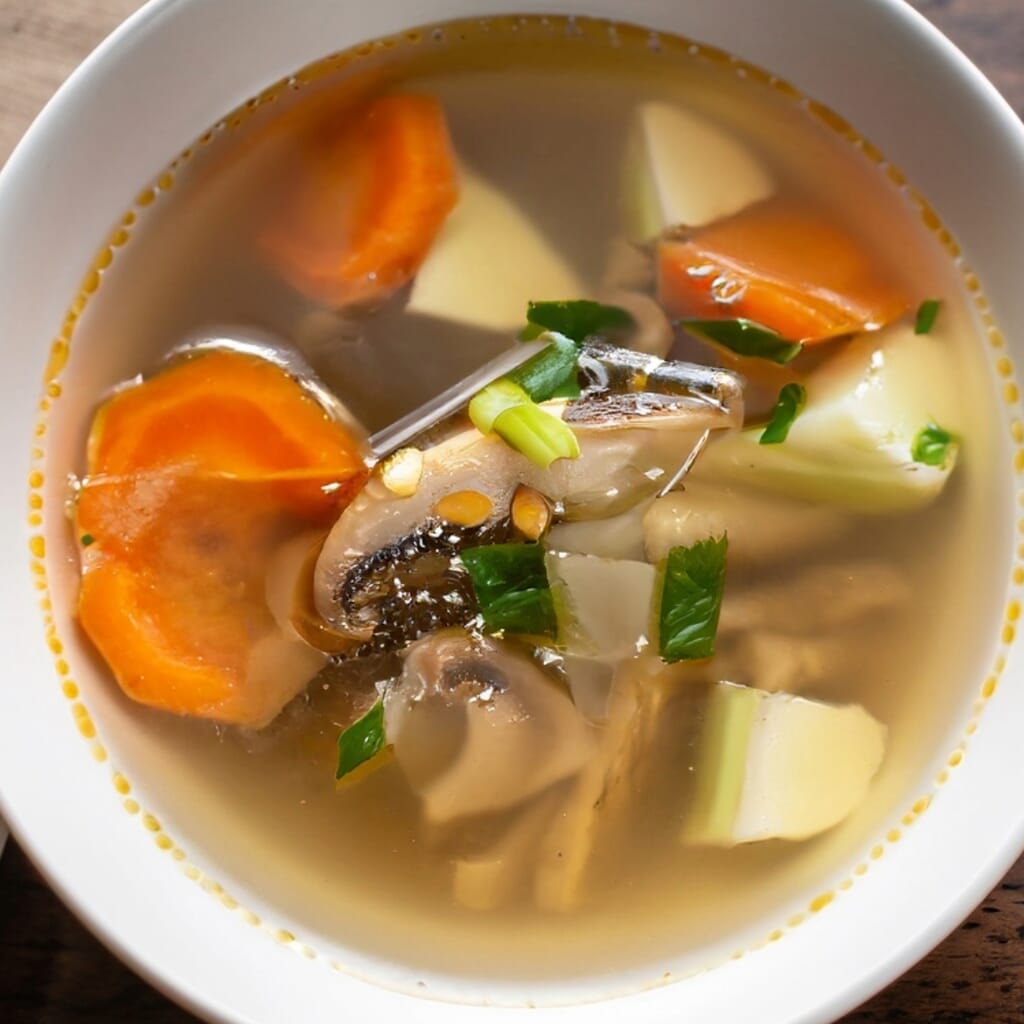
Using ingredients that are readily accessible in Japan, suimono transforms them into a harmonious blend of spicy, earthy, and warming elements.
Each sip of this delicacy promises not only a burst of flavor but also a glimpse into the rich history and traditions of Japanese cuisine.
It serves as both a comfort dish and a culinary journey for those who partake.
What Is Japanese Clear Soup?
Some people would rather call suimono a broth than a soup because the result is very thin.
Because the Soup is thin, we wouldn’t call it a dinnertime meal unless you serve it alongside other Japanese food. Instead, it would do well as a light lunch.
The most important part of this Soup is its mushroom aesthetic. Although the liquid is somewhat clear (hence the name), the mushrooms stand out as the key visual in the meal.
History Of Japanese Clear Soup
There is no real history to this Soup, as it has been around for thousands of years. Different families and regions of Japan will have their version of the broth, and none of them are wrong.
Some food historians believe that the Clear Soup is one of the oldest in recorded history. Before flour had been crushed out of wheat, and before travel was even considered, clear Soup would have been on the menu.
Poorer farmers would save the flour to make bread instead of using it as a thickening agent.
And if you were stuck or lost on your travels, all you needed was water and foraged mushrooms to make a nutrient-filled warm meal.
As the centuries have passed, the Soup has been perfected through the mixture of two stocks, the addition of spices, and a touch of greenery.
Interesting Facts About The Japanese Clear Soup
- Cultural Significance: Japanese Clear Soup is often served during traditional tea ceremonies, symbolizing purity and simplicity.
- Dashi Importance: Dashi, the base of the Soup, is considered the cornerstone of Japanese cuisine and has variations using ingredients like shiitake mushrooms or sardines.
- Seasonal Ingredients: The Soup often incorporates seasonal vegetables and proteins, aligning with Japan’s appreciation for seasonality in cuisine.
- Umami Explosion: Despite its clear appearance, the Soup is rich in umami due to the synergistic interaction of ingredients like seaweed and bonito flakes.
- Symbolism: In some traditions, specific ingredients symbolize good luck or longevity when included in the Soup.
- Culinary Art: The careful arrangement of ingredients reflects the Japanese aesthetic principle of “Wabi-Sabi,” embracing imperfection and transience.
- Nutritional Benefits: Typically low in calories and fat, it’s rich in minerals like iodine and selenium, making it a healthful choice.
What Makes The Japanese Clear Soup Special?
- Minimalist Aesthetics: Its clarity and simplicity align with the Japanese principle of “less is more,” creating a visually pleasing dish.
- Depth of Flavor: The unique combination of dashi, seasonal vegetables, and proteins offers a rich umami experience despite its unassuming appearance.
- Versatility: It can be a palate cleanser, an appetizer, or even a standalone dish, making it a flexible addition to any meal.
- Cultural Heritage: It is deeply rooted in Japanese culinary traditions, often served during formal ceremonies and family gatherings.
- Seasonal Sensibility: Ingredients often change with the seasons, reflecting Japan’s deep connection to nature and seasonality in cuisine.
- Nutritional Benefits: It balances flavor with health and is typically low in calories yet rich in essential minerals.
- Culinary Wisdom: It showcases the art of balance and subtlety in cooking, inviting the eater to appreciate each ingredient’s contribution.
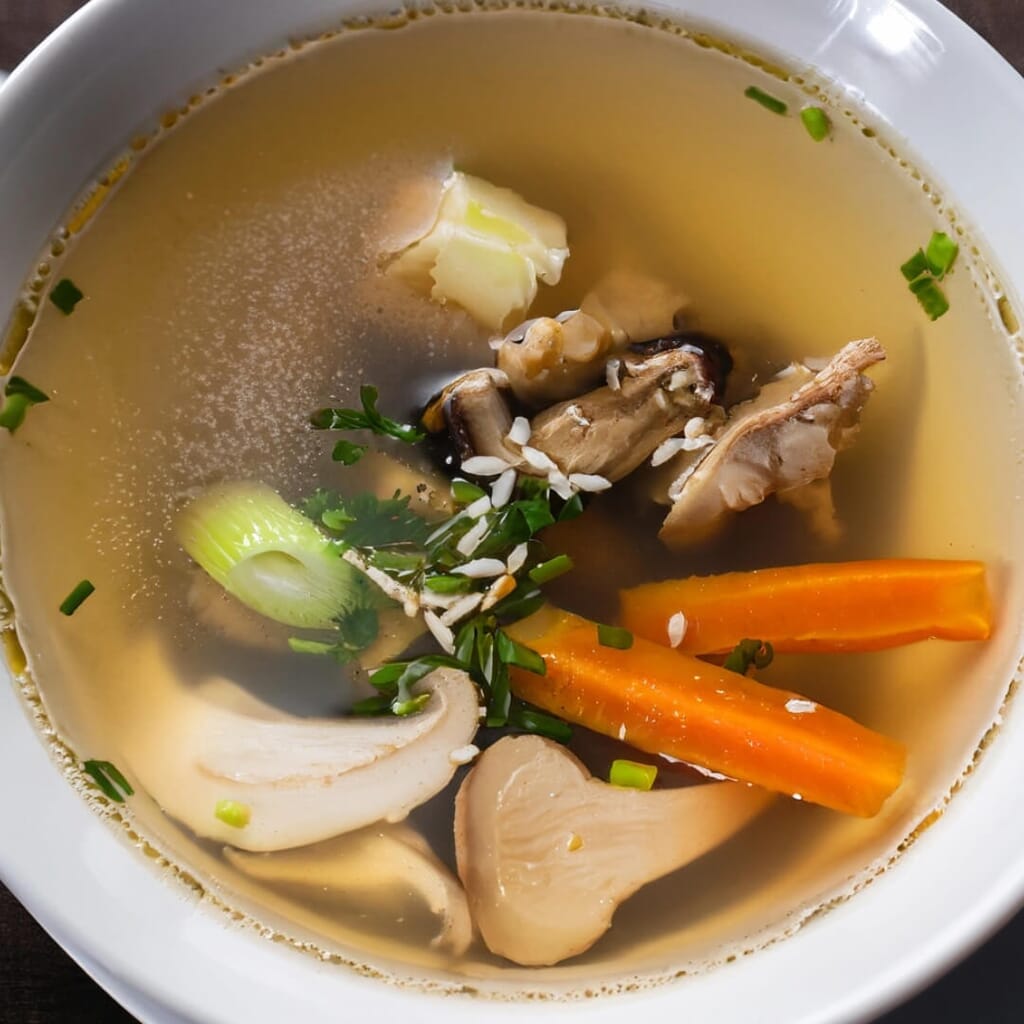
Ingredients List
| Ingredient | Quantity |
| Sesame Seed Oil | 1 tablespoon |
| Carrots | 1 ½ cups |
| Yellow Onion | 1 |
| Mushrooms | 8 oz |
| Garlic | 3 cloves |
| Scallions | 4 |
| Ginger | 1 inch |
| Salt | To taste |
| Pepper | To taste |
| Coconut Aminos | 2 tablespoons |
| Chicken Broth | 4 cups |
| Beef Broth | 3 cups |
Ingredient Tips
- Sesame Seed Oil: Opt for toasted sesame oil for a deeper, nuttier flavor profile.
- Carrots: Choose firm, bright orange carrots for the best texture and sweetness.
- Yellow Onion: A medium-sized onion usually suffices; ensure it’s fresh and firm.
- Mushrooms: Shiitake or cremini mushrooms add an umami boost; slice them consistently for even cooking.
- Garlic: Freshly minced garlic offers more flavor than pre-minced, jarred versions.
- Scallions: Use white and green parts for added color and flavor depth.
- Ginger: Fresh ginger is preferred over powdered for a more vibrant kick.
Can You Vary The Recipe With Other Ingredients?
- Keto: Replace carrots with lower-carb vegetables like zucchini. Use bone broth for added nutrients and flavor.
- Paleo: Skip the sesame seed oil and use avocado or coconut oil. Use Coconut Aminos instead of soy sauce.
- Gluten-Free: Make sure the broths and Coconut Aminos are certified gluten-free.
- Whole30: Use homemade compliant broths and Coconut Aminos, and skip any processed seasonings.
- Vegetarian: Substitute chicken and beef broths with vegetable broth. You can add tofu for extra protein.
- Vegan: Along with using vegetable broth, replace any animal-derived ingredients with plant-based options. For umami, consider adding nutritional yeast.
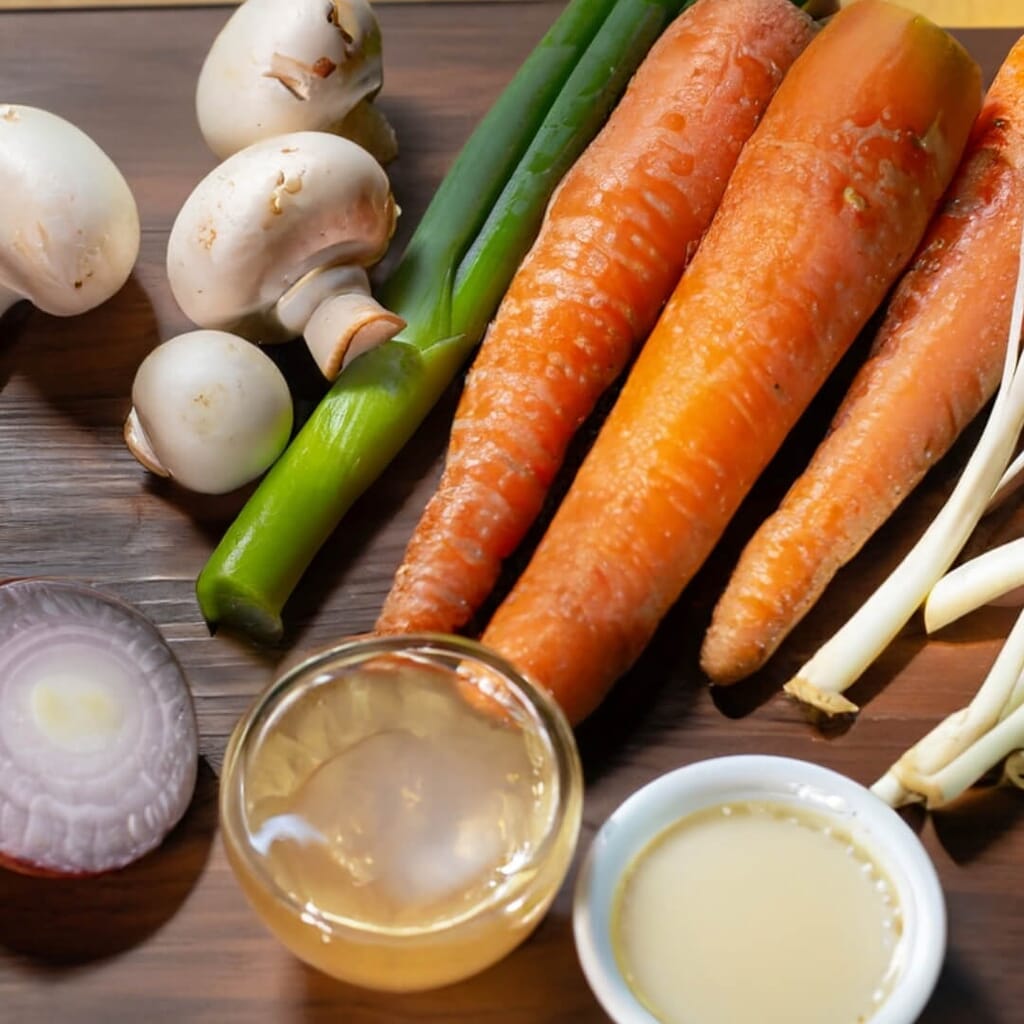
Recipe Directions
- Cooking: In a large pot, sauté carrots, ginger, onions, and garlic in sesame seed oil on medium heat for 10 minutes.
- Blending: Add both broths and coconut aminos. Stir and bring to a boil. Simmer for 1 hour, covered.
- Straining: Strain the liquid into another pot and discard the vegetables.
- Final Touches: Add scallions and mushrooms and simmer for 8 minutes.
- Serving: Serve hot.
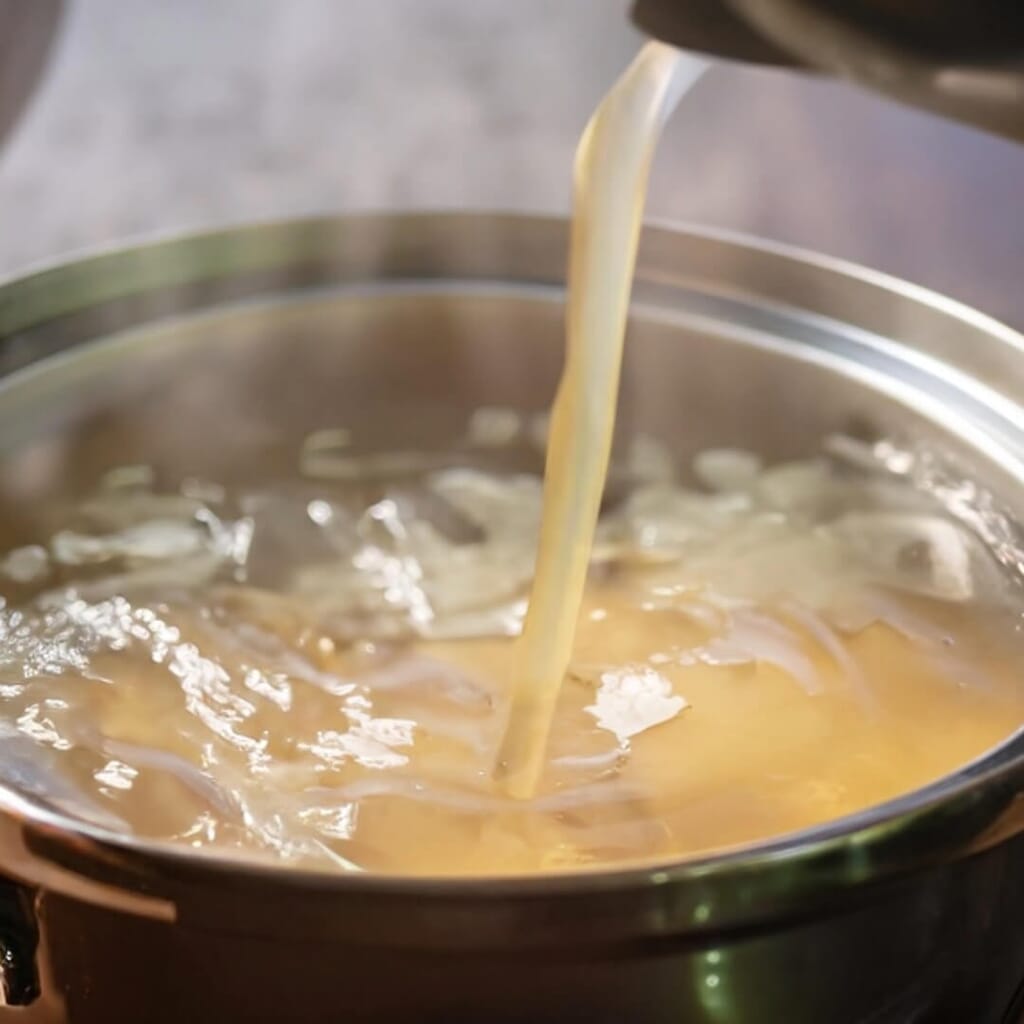
Variations, Add-Ons, And Toppings
Variations
- Seafood: Incorporate shrimp or fish for a maritime twist.
- Vegetarian: Use vegetable broth and tofu cubes as a protein substitute.
- Spicy: Add a chili oil or a few slices of jalapeño for heat.
Add-Ons
- Protein: Chicken, tofu, or thinly sliced beef can add a satisfying protein punch.
- Noodles: Add udon or soba noodles for a heartier version of the Soup.
- Leafy Greens: Spinach or bok choy can add color and nutrients.
Toppings
- Herbs: Fresh parsley, cilantro, or even mint can bring a new layer of flavor.
- Seeds: Toasted sesame seeds or flaxseeds can add a bit of crunch.
- Citrus: A squirt of lime or lemon juice can elevate the entire dish with acidity.
Scaling The Recipe
- Ingredient Proportion: Maintain the ratios between the main components like broth, vegetables, and seasonings. If the original recipe serves 3 and you want to serve 6, double all the ingredients.
- Cooking Vessel: Ensure that your pot is large enough to accommodate the increased volume if scaling up or that it’s appropriately sized for smaller quantities.
- Cooking Time: The initial sautéing and simmering times may increase slightly for larger quantities. For smaller amounts, keep an eye on the pot to avoid overcooking.
- Taste Test: When scaling, always taste for seasoning and adjust as necessary.
- Serving: For scaled-up versions, consider serving in a communal pot for larger gatherings or portioning into individual servings for smaller ones.
What Is Used For Garnishing?
- Green Onions: Finely chopped scallions add a pop of color and a subtle oniony zest.
- Fresh Herbs: Parsley, cilantro, or shiso leaves can enhance the Soup’s aromatic qualities.
- Sesame Seeds: Toasted white or black seeds contribute texture and a nutty undertone.
- Citrus Zest: A sprinkle of lemon or yuzu zest can brighten the dish’s tangy aroma.
- Seaweed: Thin strips of nori or wakame add a marine flavor and an appealing visual element.
- Chili Flakes: A dash of red chili flakes can provide a spicy kick for those who like a little heat.
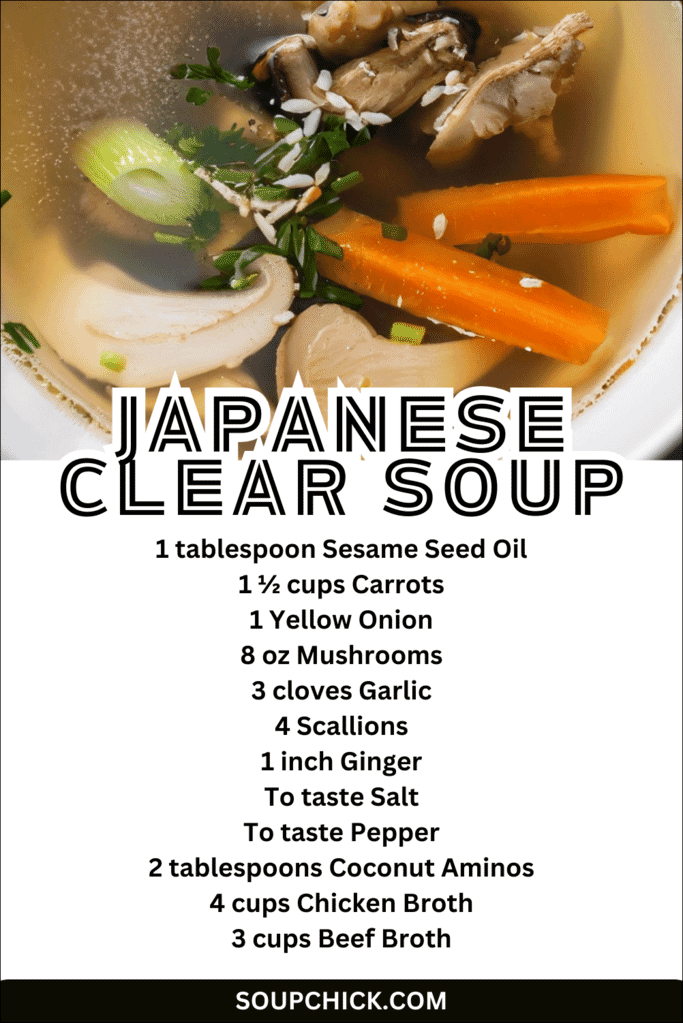
Can I Make Japanese Clear Soup In A Slow Cooker Or Instant Pot?
Slow Cooker
- Add all your ingredients—except for items like scallions and mushrooms that you’ll add later—into the slow cooker.
- Set it low for 4-6 hours or high for 2-3 hours. Before serving, strain the liquid, return it to the cooker, add the remaining ingredients, and let them simmer until soft.
Instant Pot
- Use the sauté function for your initial sautéing of vegetables. Then add the broths and coconut aminos. Seal the lid, set it to manual pressure for 15 minutes, and quick-release.
- Strain and return the liquid to the pot to add the remaining ingredients and use the sauté function to simmer them.
Can I Use Store Bought Broth, Or Should I Make My Own?
Store-Bought
- Convenience is the primary benefit here. Look for high-quality, organic, and low-sodium options for better control over seasoning. Some even come with added flavors like herbs or garlic for extra depth.
Homemade
- Making your broth allows complete control over ingredients and flavor profile. It can be more nutritious and free of preservatives or additives. Homemade broth can also be tailored to specific dietary requirements, such as low-sodium or vegetarian.
Can I Use Different Types Of Meat/Fish/Pasta/Vegetables For The Soup?
Meat/Fish
- Feel free to include proteins like chicken, beef, or seafood like shrimp and fish. For a smoky flavor, try smoked turkey.
Pasta
- Traditional Japanese noodles like udon or soba can make the Soup heartier. For a gluten-free option, consider rice noodles or zucchini spirals.
Vegetables
- Swap in or add different veggies for variety. Think zucchini, bell peppers, or leafy greens like spinach or kale. Root vegetables like turnips can add earthiness.
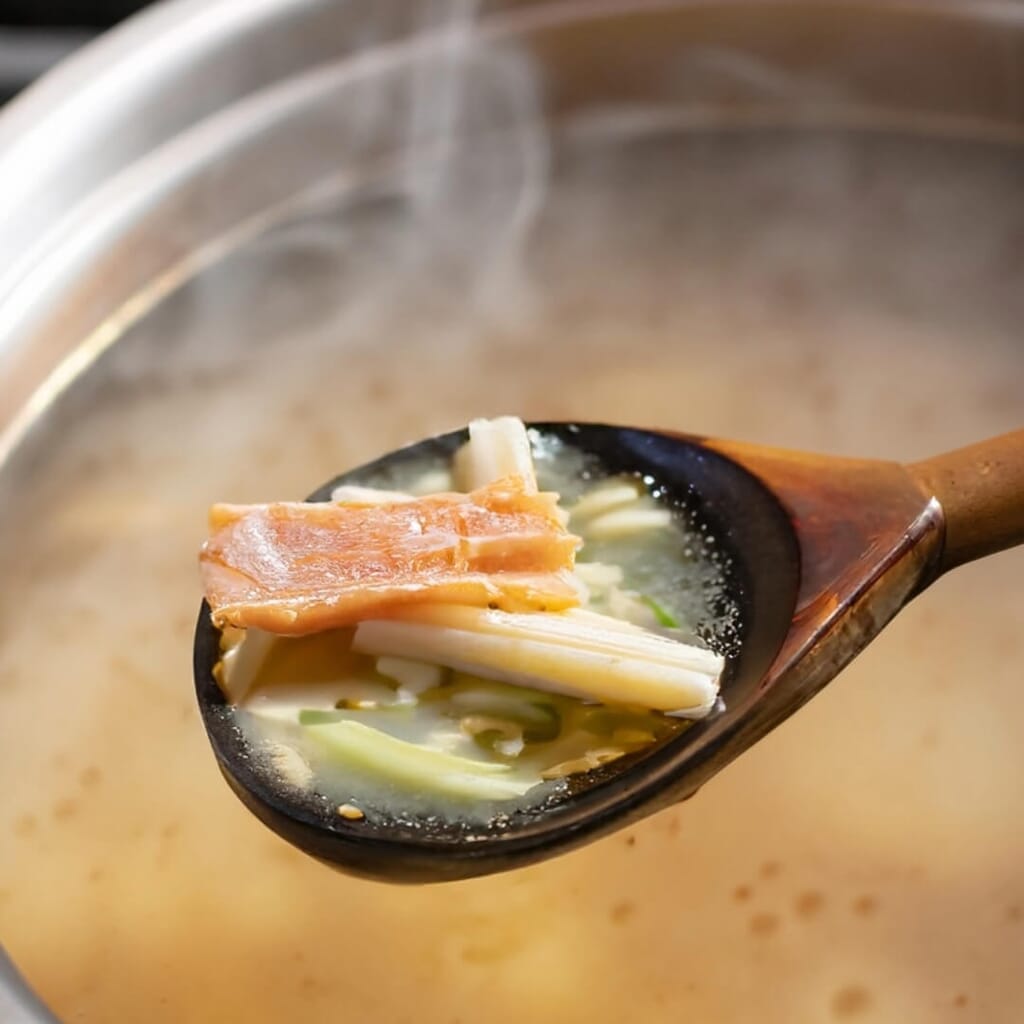
Success Tips – Tips And Tricks For Making The Soup
Mastering the art of soup-making is all about attention to detail. Here are some tips and tricks to elevate your Japanese Clear Soup to gourmet levels:
Prepping Tips
- Consistent Chopping: Make sure to chop your veggies uniformly for even cooking.
- Fresh Herbs: Use fresh over dried herbs for a more vibrant flavor profile.
- Pre-measure: Have all your ingredients measured and ready to avoid last-minute chaos.
Cooking Time Tips
- Low and Slow: Simmering the Soup on low heat helps extract maximum flavor from ingredients.
- Taste as You Go: Regularly taste and adjust seasonings for a balanced flavor.
- Timing: Add quick-cooking items like mushrooms or noodles towards the end to avoid overcooking.
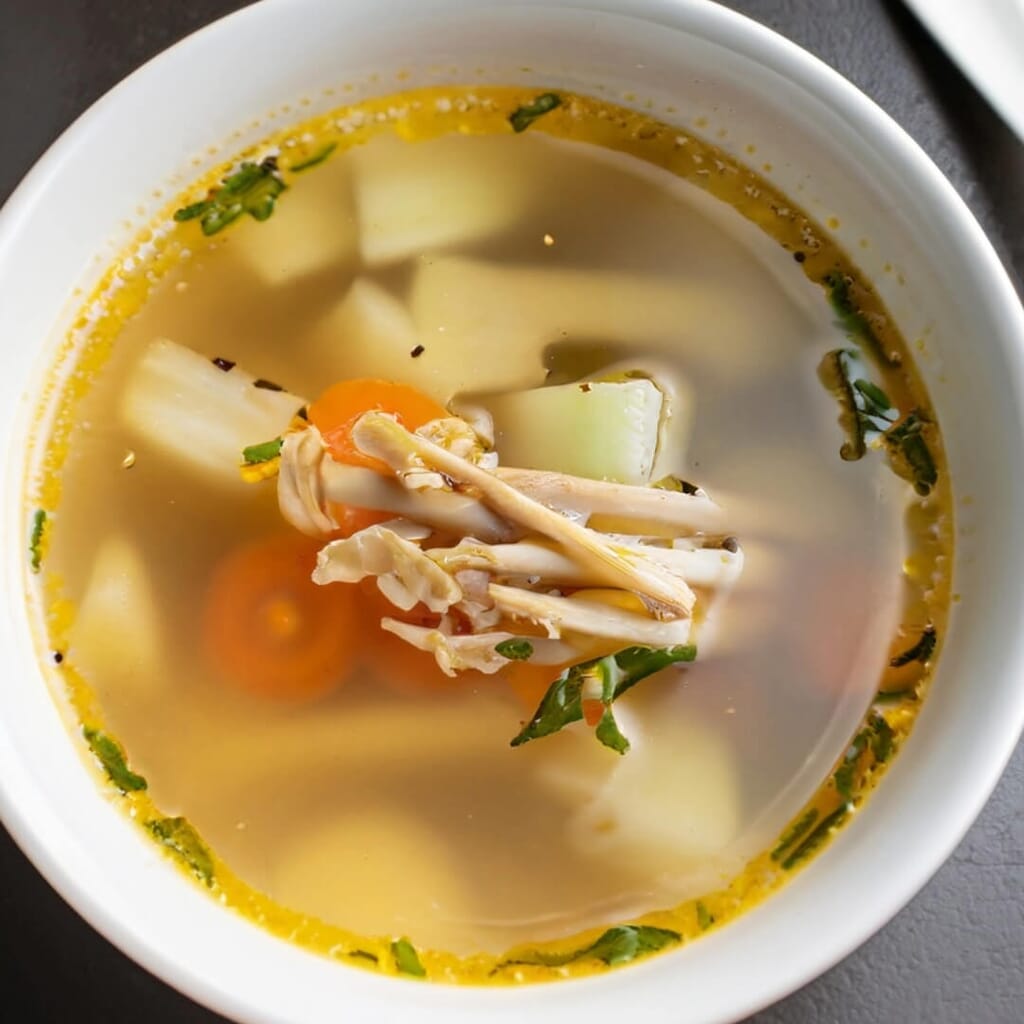
Nutritional Values
Japanese Clear Soup offers more than taste. It’s a low-calorie delight, rich in essential vitamins and minerals. Dive into this bowl of health and flavor!
What Are The Total Calories In The Soup?
Generally, broth-based soups like this are relatively low in calories, especially if made primarily with vegetables and lean protein.
A basic recipe might range between 50-100 calories per serving, assuming a serving size of approximately 1-1.5 cups.
However, it depends on whether you include protein like chicken or tofu. Additions like sesame oil, Coconut Aminos, and other proteins or fats will also increase the calorie count.
Dietary Restrictions Of The Japanese Clear Soup
- Gluten-Free: Ensure the broth and added sauces like Coconut Aminos are gluten-free. Check labels carefully.
- Vegetarian/Vegan: Use vegetable broth instead of chicken or beef broth, and replace animal-based proteins with tofu or tempeh.
- Low-Sodium: Opt for low-sodium broth and be cautious with added salt or soy-based sauces.
- Keto/Paleo: Use a high-fat, low-carb broth and omit any high-carb vegetables or noodles.
- Whole30: Stick to compliant broths and Coconut Aminos, and avoid legumes or grains.
- Nut Allergies: Ensure that the broth and any added sauces are free from nut-based ingredients.
Health Benefits Of The Japanese Clear Soup
- Low Calorie: It’s a low-calorie option that can aid in weight management.
- Hydrating: The high liquid content can help keep you hydrated and may even assist in detoxification.
- Nutrient-Rich: Vegetables like carrots, onions, and mushrooms provide essential vitamins and minerals.
- Digestive Aid: Ginger and garlic are known for their digestive and anti-inflammatory benefits.
- Bone Health: If made with bone broth, the Soup can be a good source of collagen and other nutrients beneficial for joint and bone health.
- Immunity Boost: Ingredients like garlic and ginger contain immune-boosting properties.
- Adaptable: Can be easily modified to suit dietary restrictions while retaining its healthful qualities.
Nutrition Table
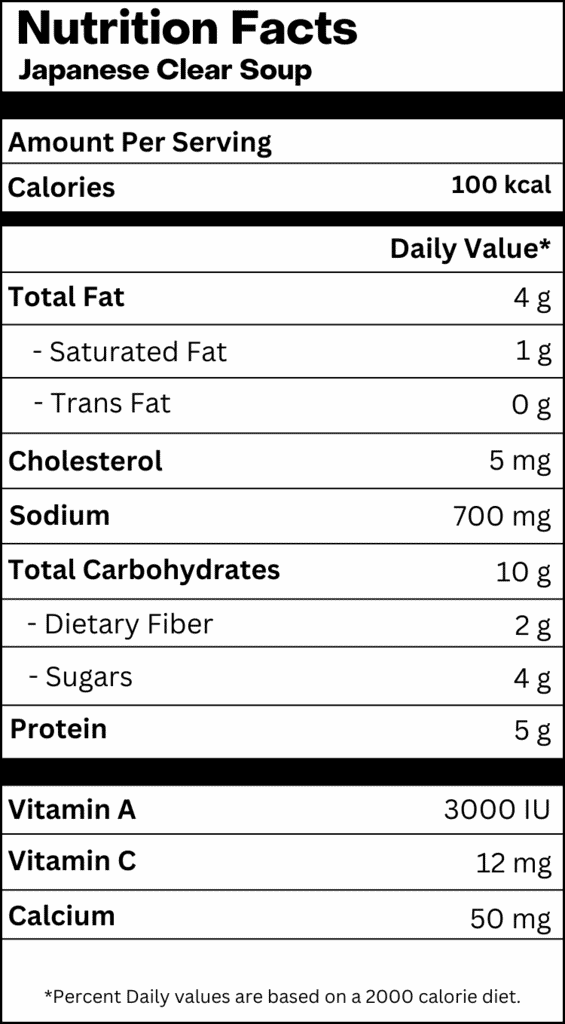
How Can I Make Japanese Clear Soup Lower In Sodium?
- Broth Choice: Opt for low-sodium or unsalted broths in most stores. Alternatively, making your broth allows for complete sodium control.
- Sauces: Reduce or omit the Coconut Aminos and replace them with a low-sodium soy sauce or tamari, using it sparingly.
- Fresh Herbs: Incorporate fresh herbs like cilantro, parsley, or chives to enhance flavors without added salt.
- Natural Flavor Enhancers: Ingredients like garlic, ginger, and fresh lemon or lime juice can elevate the taste profile without contributing sodium.
- Limit Added Salt: Use minimal added salt, and encourage diners to season their serving if desired.
How Can I Make Japanese Clear Soup Lower In Sugar?
- Natural Ingredients: Use fresh vegetables without added sugars, avoiding pre-packaged ones which might contain sweeteners.
- Broth: Select broths without added sugars, as some commercial broths might contain hidden sweeteners.
- Sauces: Coconut Aminos have a slightly sweet profile. Consider reducing its quantity or using low-sugar soy sauce versions.
- Monitor Vegetables: While all vegetables add some natural sugars, limit those with higher sugar content, like carrots or onions.
- Fresh Herbs: Enhance the flavor with fresh herbs, which add depth without contributing sugars.
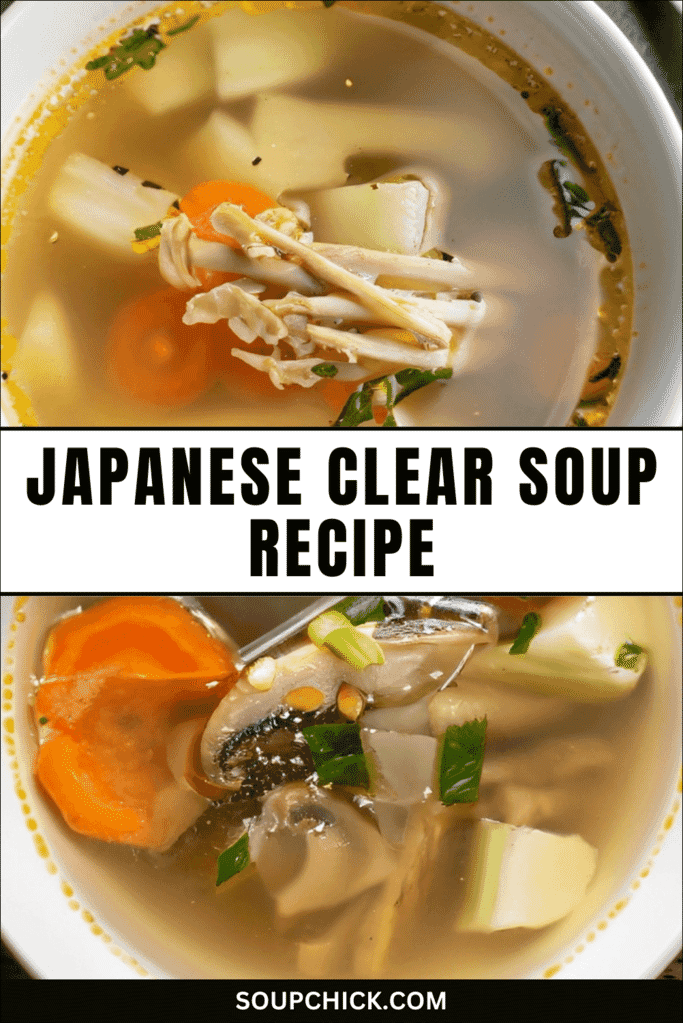
How To Serve The Japanese Clear Soup At Its Best?
- Temperature: Ensure the Soup is served hot. Using a warmed bowl can help retain its temperature longer.
- Presentation: Use deep, wide bowls to showcase the clear broth. Place a few pieces of vegetables or meat in the bowl’s center for visual appeal.
- Garnish: Freshly chopped scallions, a sprinkle of sesame seeds, or a dash of red pepper flakes can add color and flavor contrasts.
- Accompaniments: Serve with a side of steamed white or brown rice or even traditional Japanese pickles.
- Timing: Serve immediately after preparation to retain the flavors and warmth, ensuring the freshest taste experience.
Perfect Side Dishes To Complement Japanese Clear Soup
With most Western foods, you expect to serve the Soup with a side of bread. However, in Eastern cultures, you can expect something called ichiju-sansai, which is “one soup, three sides.”
The sides are meant to offer balance. This balance is aimed at flavor, textures, and nutrition.
Japanese Clear Soup has a light texture, deep earthy flavors, and thin density.
We need dense food, light flavor, and exciting textures to balance this.
Remember that each bowl (including the clear Soup) should be small so we balance the total amount. The aim isn’t to overeat.
Hibachi Chicken
- Hibachi chicken is considered a comfort food, just like clear Soup. With this side, we aim to balance the earthy flavors of suimono with the spicy and sweet flavors of Hibachi.
- You’ll need chicken breast cut into chunks, mayonnaise, ground mustard powder, honey, coconut aminos, and garlic powder.
- Mix all ingredients, minus the chicken, and let the chicken marinade in the flavors. After an hour, cook the chicken usually, and you’ll have a spicy and sweet side.
- Many people would pair this chicken with vegetables cooked in the same sauce. Keep that in mind for any future recipes.
Lettuce Wraps
- Lettuce wraps are no secret in the cooking world. Sprinkle some ingredients into the lettuce and wrap it like a tortilla. We will give you more direction, but that’s it.
- Lettuce wraps are an excellent balance for Clear Soup because of the change in texture and temperature. Lettuces have a beautiful crack or snap, which directly contrasts the Soup’s smooth liquid texture.
- To connect the food to our ensemble, we suggest using a Hibachi steak or Hibachi vegetable stuffing for the wrap.
- This means using the same ingredients of mayonnaise, ground mustard powder, honey, coconut aminos, and garlic powder.
- Mix them and then use them as a light sauce to drizzle across either steak and rice or cucumber and rice.
- To create the wrap, lay your crisp lettuce down first, then the cold rice, the main topping (steak or cucumber), and the sauce.
- You can serve this plate with extra sauce on the side.
Mushroom Fried Rice
- Lastly, we want to bring the mushroom flavor back onto the table. It is the star of this meal, after all.
- To make mushroom-fried rice, you’ll need rice, eggs, garlic, soy sauce, and mushrooms.
- Cut up the mushrooms and garlic into small pieces. Cook the rice in boiling water, while in a pan, saute the mushrooms and garlic. Then add in the rice, soy sauce, and eggs. The eggs will combine the ingredients.
- Once all is cooked, you can mold the rice into a bowl and serve it as your side.
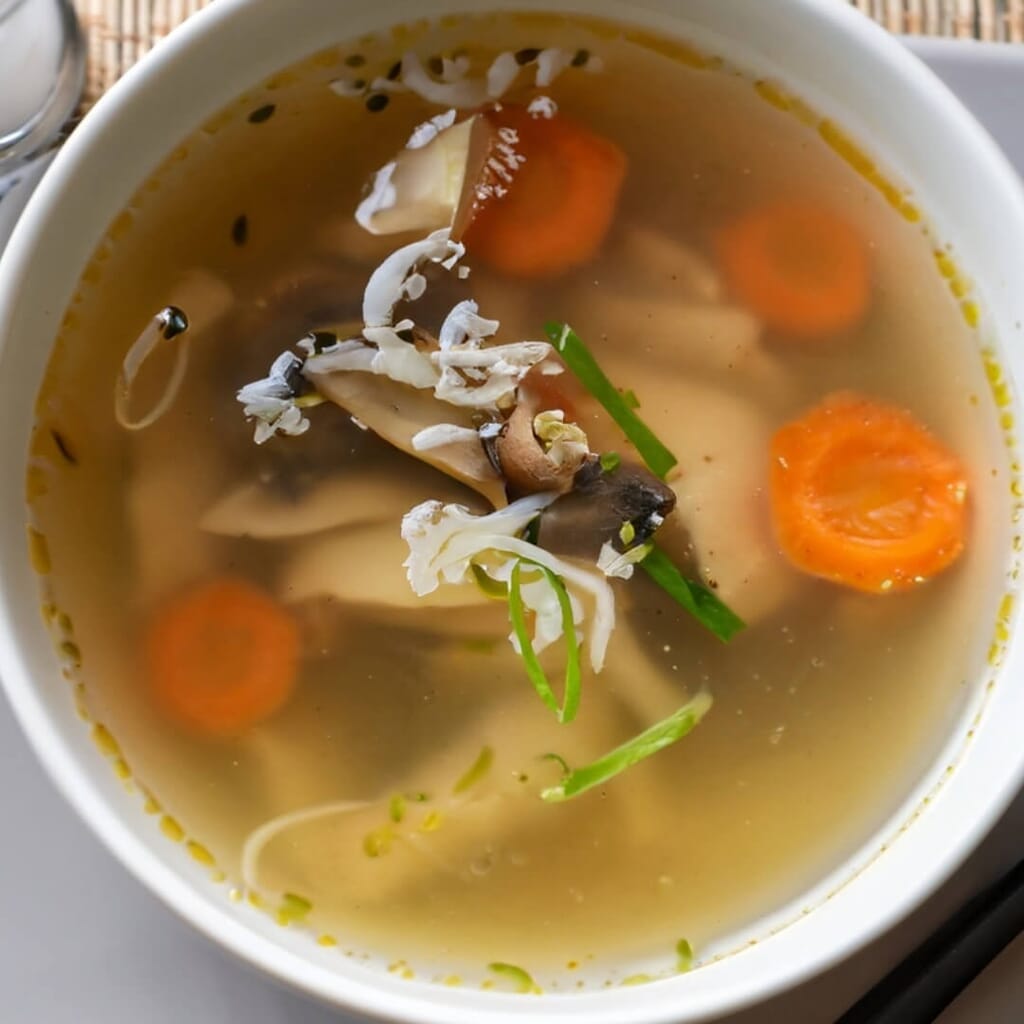
How Long Can We Store The Soup?
- If you’ve made too much Soup and want to store it for another day, put the excess into an air-tight container and allow it to cool.
- Once cooled, put the Soup into the refrigerator. It will last for 3 to 4 days. If you need a longer storage time, put it in the freezer; it will last 3 months.
- When you’re ready to eat the Soup, you can reheat it in the microwave. First, allow the Soup to defrost. Then put on medium heat and cook for 5 minutes until it simmer.
- You can put tin foil around the air-tight container as an extra tip. This will distribute the heat, allowing you to put it into the refrigerator immediately, as it takes longer to cool down.
- This will prevent the container from breaking and the food from cooling too quickly and removing the flavor.
Can I Make The Soup In Advance?
- Preparation: Chop and measure out all ingredients a day ahead and refrigerate.
- Cooking: You can fully prepare the Soup a day or two before serving. Flavors often meld and improve with a little time.
- Storage: Cool the Soup quickly to room temperature once cooked, then refrigerate in an airtight container.
- Reheating: Gently reheat on the stovetop until simmering, ensuring even heating.
What Can We Do With Leftovers?
- Rice Add-in: Pour the Soup over steamed rice for a comforting rice porridge.
- Stir-fry Base: A flavorful liquid base for stir-frying veggies or protein.
- Noodle Soup: Introduce cooked ramen, udon, or soba noodles for a quick noodle soup meal.
- Casserole Foundation: Incorporate into casseroles for enhanced moisture and taste.
- Sauce Reduction: Simmer until reduced and used as a sauce for meat or vegetables.
- Soup Remix: Add different veggies, proteins, or spices to create a new soup variant.
- Freeze for Later: Portion and freeze for a ready-made soup on hectic days.
- Egg Drop Soup: Stir in beaten eggs for a Japanese twist on egg drop soup.
- Poaching Liquid: Poach fish or chicken in the Soup for added flavor.
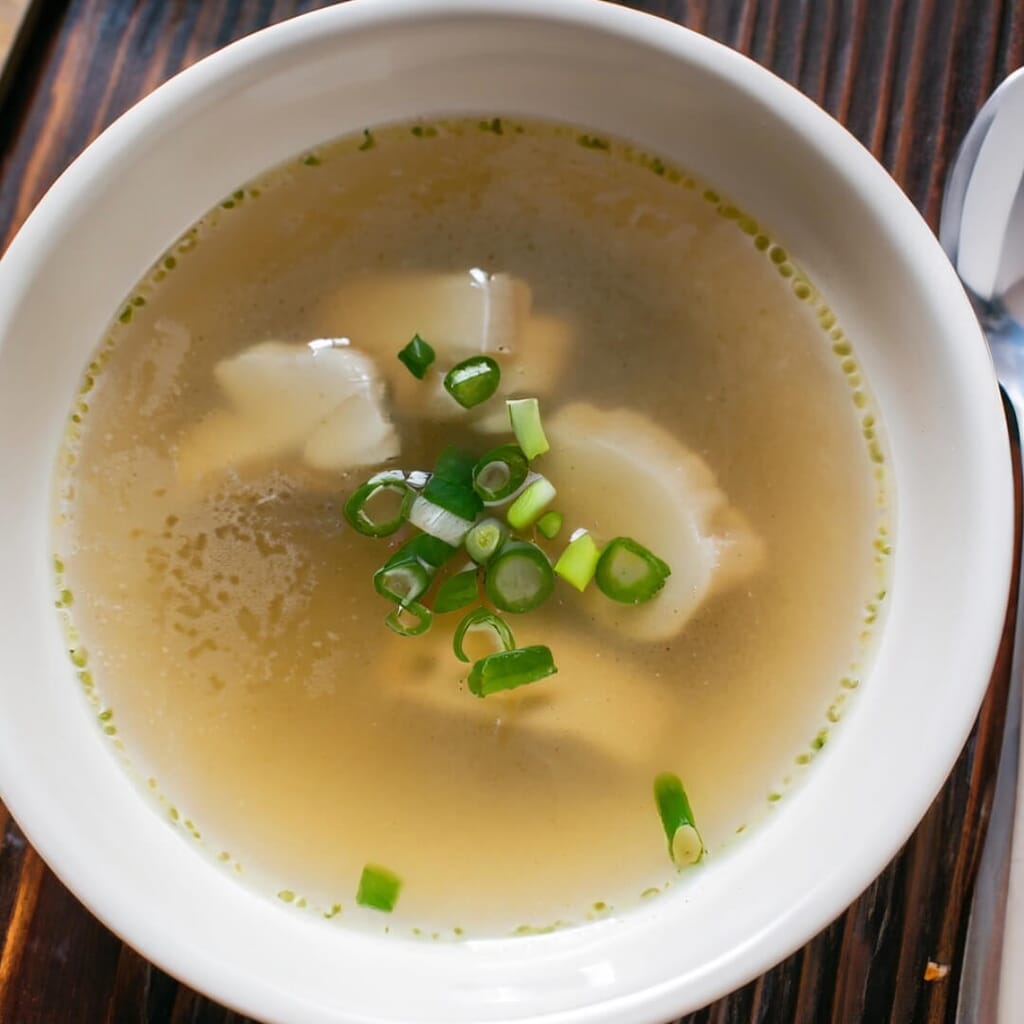
Special Tools/Equipment Needed
- Japanese Donabe: A traditional clay pot simmering soups and stews, retaining heat well and enhancing flavors.
- Fine Mesh Sieve: For straining the Soup to achieve its signature clarity.
- Mortar and Pestle: Helpful for grinding and releasing flavors from ingredients like ginger or garlic.
- Chopsticks: Useful for stirring ingredients and serving.
- Wooden Soup Spoons: Traditional ladles for serving the Soup.
- Vegetable Peeler: For skinning ginger or other ingredients.
- Sharp Knife: Essential for thinly slicing vegetables and achieving uniform sizes.
- Instant Pot or Slow Cooker: Optional but convenient for unattended cooking.
Final Thoughts
Clear Soup is an easy broth to create. Preparing takes little time, but you’ll have a rich and delicious snack.
Add in sides of mushroom fried rice, lettuce wraps, and Hibachi chicken, and you’ll have a delicate and delightful dinner.
Frequently Asked Questions
What Is Japanese Clear Soup Called In Japan?
Clear Soup has many names in Japan. We have used the name suimono, but it is also called sumashijiru, otsuyu, and osumashi.
As with many languages, words often lose their meaning or the meaning changes over time. Suimono means “accompaniment to a drink,” while “shiru” means served with rice.
What Are Common Traditional Japanese Soups?
The most popular traditional Japanese soups are miso soup, zosui soup (rice soup), egg drop soup, and Tonjiru (pork soup).
What’s The Difference Between Japanese Clear Soup And Miso Soup?
While both are staple soups in Japanese cuisine, Clear Soup emphasizes a transparent broth made from meat or fish stock. At the same time, Miso Soup uses a fermented soybean paste base, resulting in a cloudy appearance and distinctively rich flavor.
Can I Add Tofu To The Clear Soup?
Absolutely! Silken tofu can be cubed and added during the final stages of cooking, providing additional protein and a soft texture that complements the clear broth.
How Does The Soup Fit Into A Traditional Japanese Meal?
Japanese Clear Soup often acts as a palate cleanser, typically served after appetizers and before the main course, helping transition between flavors and setting the stage for the dishes to follow.
- Papaya Salad Recipe (Sweet And Sour Flavors) - January 15, 2024
- Burrata Salad Recipe (A Blend Of Italian Elegance) - January 12, 2024
- Pear Salad Recipe (Healthy Flavorful Twist To Try) - January 12, 2024

